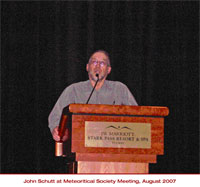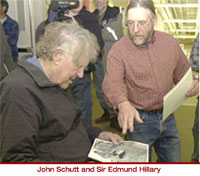


This newsletter reports 386 new meteorites from the 2004, 2005 and 2006 ANSMET seasons from the D’Angelo Bluff (DNG), Graves Nunatak (GRA), Grosvenor Range (GRO), LaPaz Icefield (LAP), Larkman Nunatak (LAR), MacAlpine Hills (MAC), Miller Range (MIL), Mount Pratt (PRA), Roberts Massif (RBT), Scott Glacier (SCO), and Taylor Glacier (TYR) areas. There is something for everyone in this newsletter, including lunar meteorites (2), a shergottite, 3 different and unusual ungrouped achondrites (see below), H impact melts (3), howardites (2), eucrites (4), irons (4), H3 chondrites (2), an L3 chondrite, an EH3 chondrite, and a variety of carbonaceous chondrites (14 CM2, a CM1, 3 CR, 2 CK, and 4 CV).
There are four very rare meteorites in this newsletter. The most unusual of these, GRA 06129 (and its pair, GRA 06128), is difficult to classify due to its unusual composition. It has very sodic feldspar (Ab85 ) and ferroan olivine (Fa59 ) and pyroxene, contains high Ni FeNi metal, and has oxygen isotopic composition overlapping the Earth, Moon and enstatite meteorites. Everyone working on this sample has noted the ubiquitous sulfurous smell. This unusual composition is unlike any lunar sample yet studied, has extensive fusion crust (so it is not terrestrial), and is more oxidized than any of the enstatite meteorites. Given these features, its parent body is uncertain. Studies of its age, noble gas content and composition, trace element compositions, and volatile element contents will be very interesting. Given the reasonable size of this meteorite, there will be no shortage of material available for research. However, we nonetheless encourage researchers to form consortia that will allow the best and most efficient use of sample mass to learn more about this unusual meteorite.
Two of the other rare meteorites are lunar breccias that are unfortunately very small (< 8 g). Again, we encourage researchers to put together consortium studies to maximize scientific impact given sample mass. Finally, the fourth sample is an olivine phyric shergottite. The relation of this sample to any other olivine phyric shergottites in worldwide collections will be of great interest.
John Schutt Honored at 70th Meteoritical Society Meeting in Tucson
| We are pleased and proud to announce that ANSMET mountaineer John Schutt has been awarded the Meteoritical Society Service Award in Tucson Arizona on August 14, 2007. Cited by Ralph Harvey at the award ceremony, John’s incredible contributions to the ANSMET program and meteoritics in general were celebrated. Having been involved with 25 different field seasons and spending close to 5 years of time living in Antarctica, John has a truly unique perspective on meteorite hunting. His acceptance speech was eloquent and inspiring, giving us even more to marvel at – Congratulations, John! |  |
|
 |
 |
With this newsletter, the characterization of the 2005-2006 season meteorites is complete. Collection by the main team in the Miller Range yielded 4 HED meteorites, a beautiful rare lunar gabbro, a IIIAB iron, a small and unusual bencubbinite, 9 other carbonaceous chondrites (CM, CO), several L chondrite impact melts, and 2 enstatite chondrites. Searching at MacKay Glacier resulted in 9 carbonaceous chondrites (CK, CM, CV) and a mesosiderite. Taylor Glacier samples included an L5 and a IIE iron. A summary of the finds for ‘05 samples (or any other season) can be generated using our advanced search on the classification database on our webpage: https://curator.jsc.nasa.gov/antmet/query.cfm.
Personnel Changes in the Antarctic Meteorite GroupThe Antarctic Meteorite collection at JSC has had a lot of personnel changes since the last newsletter. In March, Nancy Todd joined ARES as our new database administrator. Nancy has already demonstrated her proficiency with the FoxPro meteorite database and is making some great contributions to the curation group. In May, Penny Robinson, who made thin sections for the meteorite lab for many years – decided to leave ARES. Since Kevin Righter has been curator, Penny made >600 beautiful thin sections so her absence was felt immediately – we wish Penny the best of luck in her new endeavors. More recently, the curation group has hired Roger Harrington as a sample processor for both the lunar and meteorite collections, Michelle Crush as a new thin section technician, and Lisa Owens as a new lab technician supporting all of our collections. All four of these new colleagues will be contributing to the Antarctic Meteorite group and we are happy to have so many new people.
Lunar Meteorite CompendiumA compendium of 42 lunar meteorites was completed by the MPL staff, and placed online in May 2007. Because there are new lunar meteorites being discovered annually, these will have to be periodically updated. If you know of any research that is not mentioned or covered in the chapters, please let us know – they are intended to be comprehensive summaries of samples. Send information to: kevin.righter-1@nasa.gov. We will update them as frequently as we can.
Update on Thin Section RecallsIn the Spring of 2007, we initiated a thin section recall for the US Antarctic Meteorite Collection. We have received many sections back from a great number of researchers, and we want to thank everyone for their cooperation. There are some PI’s who have not yet responded and we will be contacting you soon. Remember, if you request samples from our collection, but have not yet complied with the thin section recall, your request will be tabled until this situation is reversed.
ReclassificationsWe have a number of samples from our collection that need to be updated from the original classification, due to new information. Some of these are unusual meteorites that did not have a clear classification from the start, or which had unique features discovered after an otherwise standard classification. Others are ordinary chondrites that are initially classified by optical means.
| Sample | Previous | New | Reference |
|---|---|---|---|
| PAT 91516 | Iron | L7 | 1 |
| PAT 91528 | Iron | L7 | 1 |
| GRO 95577 | CM2 | CR1 | 2 |
| MAC 88107 | CM2 | Ungrouped Chondrite | 3,4,5 |
| QUE 97008 | L 3.4 | L 3.0 | 6 |
| EET 90161 | L 3.4 | L 3.0 | 6 |
| MET 00526 | H 3.2 | H 3.0 | 6 |
| QUE 93148 | Iodranite | Ungrouped Achondrite | 7 |
| MET 01210 | Anorth. Regolith Breccia | Anorthosite-bearing basaltic fragmental breccia | 10 |
| PCA 02007 | Basaltic Regolith Breccia | Anorth. Regolth Breccia | 11 |
The small PAT samples were originally classified as irons, but with the complete characterization of the 1991 PAT samples, and the recognition of the proximity of these samples to the PAT91501 L7 chondrite, it became clear that these are most likely small pieces of metal paired with PAT 91501 [1]. GRO 95577 was originally classified as a CM2 meteorite, but more detailed studies by [2] indicate that its bulk composition is actually that of a CR, and it has undergone more extensive aqueous alteration than a CR2, so it has been reclassified as a CR1. MAC 88107 was also originally classified as a CM2, but bulk compositional, and oxygen isotopic studies [3,4,5] all suggest that it is intermediate between CM and CO, and should be reclassified as an ungrouped carbonaceous chondrite. The several ordinary chondrites listed above were originally classified as higher grade 3, but recent approaches to classification have identified these as much lower grade, close to 3.0 [6]. Furthermore, chondrules sizes in MET 00526 are more consistent with being an L chondrite than an H [6]. As a result, they have all been reclassified accordingly. QUE 93148 was originally announced as a lodranite. Several years ago we changed this to “ungrouped achondrite”, but never officially announced this. The reason is that it has bulk, trace element, and oxygen isotopic composition overlapping with the HED and pallasite groups [7]. Brecciated lunar meteorites are notoriously difficult to classify based on one or even two thin section due to sample heterogeneity on a large scale. MET 01210 was originally classified as an anorthositic regolith breccia (based on one thin section), but studies since then have recognized that it has more basaltic material than anorthositic. Similarly, PCA 02007 was originally classified as a basaltic regolith breccia, but detailed studies have shown that most clasts and material in this sample are feldspathic.
The second group of samples consists of ordinary chondrites studied by K. Welten and K. Nishiizumi for cosmic ray exposure age dating. As part of this study, they have acquired Ni and Co data for the bulk metal (using techniques described in [9]). Comparison of Co contents to the H, L, and LL groupings of [8], revealed that a subset of samples from their study were incorrectly classified [9]. Listed here are 29 samples with their previous classification, new classification and Ni and Co in the bulk metal. These are all either H or L chondrites. At the end of the list are three additional samples that have higher Ni and Co contents (where distinction between L and LL is less clear), and may be L or LL. The classification of these samples is unclear, and they are listed here to warn anyone working on these samples, that they should verify the original classification.
Sample Previous New Co wt% Ni wt%
ALH 99506 L5 H5 0.45 10.1
BTN 00305 L5 H5 0.46 10.2
BTN 00307 L6 H6 0.47 10.7
EET 99410 H6 L6 0.63 20.9
EET 99420 H5 L5 0.71 14.3
GEO 99108 L5 H5 0.45 11.8
GRA 95215 H4 L4 0.72 14.7
GRO 95527 H4 L4 0.67 14.5
GRO 95607 L6 H6 0.43 10.6
GRO 95616 L4 H4 0.47 10.9
LAP 02218 L4 H4 0.43 11.7
LEW 86085 L6 H6 0.48 9.5
MET 00442 H4 L4 0.65 16.5
MET 00444 LL6 H6 0.46 12.4
MIL 99310 L5 H5 0.49 9
PCA 02002 L5 H5 0.44 13
QUE 93182 L5 H5 0.46 11.7
QUE 93264 L6 H6 0.39 16.6
QUE 97009 L6 H6 0.48 9.9
QUE 97010 LL6 L6 0.67 16.9
QUE 97022 L5 H5 0.5 9
QUE 97027 L4 H4 0.45 11.9
QUE 97038 L6 H6 0.48 9.7
QUE 97039 L5 H5 0.47 10.3
QUE 97044 LL6 L6 0.61 19.9
QUE 97047 L5 H5 0.45 10.1
QUE 99010 L5 H5 0.47 10.3
QUE 99013 L5 H5 0.43 9.8
QUE 99017 LL5 H5 0.47 10.8
ALH 94001 L4 L/LL4 ? 0.9 21.5
MAC 88122 H5 LL5 0.97 27.9
WIS 90300 L/LL5 ? LL5 1.01 24.4
Finally, Ron Fodor and Kaitlin Singer of North Carolina State University have identified five ordinary chondrites whose original classifications require revision. Microprobe analyses of several samples are presented here, along with the original classification.
Sample Previous New Microprobe data
LAP 03570 LL4 L4 Fa23 , Fs13-19
BTN 00304 LL6 L6 Fa24 , Fs21
MCY 05212 L5 H5 Fa18-19 , Fs17-19
LAP 03554 H4 L4 Fa24-25 , Fs19-23
References: [1] Mittlefehldt, D.W. and Lindstrom, M.M. (1993) Meteoritics & Planetary Science, vol. 36, no. 3, p. 439-457; [2] Weisberg, M.K. and Prinz, M. (2000) Meteoritics & Planetary Science, vol. 35, Supplement, A168; [3] Russell, S.S. et al. (2000) Meteoritics & Planetary Science 35, 1051-1066; [4] Krot, A.N. et al. (2000) Meteoritics & Planetary Science 35, 1365-1386; [5] Zolensky, M.E. et al. (1993) Geochimica et Cosmochimica Acta 57, 3123-3148; [6] Grossman, J.N. and Brearley, A.J. (2005) Meteoritics & Planetary Science 40, 87-122; [7] Goodrich, C.A. and Righter, K. (2000) Meteoritics & Planetary Science 35, 521-536; [8] Afiattalab and Wasson (1980) Geochimica et Cosmochimica Acta 44, 431-443, 445, 446; [9] Welten, K. et al. (2006) Meteoritics & Planetary Science 41, 1081-1094; Welten et al. (2007) Lunar Planet. Sci. 38, #2345; [10] Arai T., Misawa K. and Kojima H. (2005) Lunar Planet. Sci. 36, #2361; [11] Korotev, R.L. and Zeigler, R.A. (2006) Geochimica et Cosmochimica Acta 70, 5935–5956.